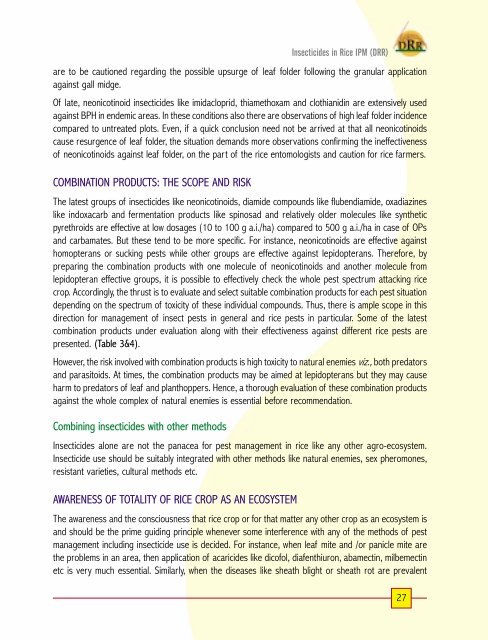priciples of insecticide use in rice ipm
priciples of insecticide use in rice ipm
priciples of insecticide use in rice ipm
Create successful ePaper yourself
Turn your PDF publications into a flip-book with our unique Google optimized e-Paper software.
Insecticides <strong>in</strong> Rice IPM (DRR)<br />
are to be cautioned regard<strong>in</strong>g the possible upsurge <strong>of</strong> leaf folder follow<strong>in</strong>g the granular application<br />
aga<strong>in</strong>st gall midge.<br />
Of late, neonicot<strong>in</strong>oid <strong><strong>in</strong>secticide</strong>s like imidacloprid, thiamethoxam and clothianid<strong>in</strong> are extensively <strong>use</strong>d<br />
aga<strong>in</strong>st BPH <strong>in</strong> endemic areas. In these conditions also there are observations <strong>of</strong> high leaf folder <strong>in</strong>cidence<br />
compared to untreated plots. Even, if a quick conclusion need not be arrived at that all neonicot<strong>in</strong>oids<br />
ca<strong>use</strong> resurgence <strong>of</strong> leaf folder, the situation demands more observations confirm<strong>in</strong>g the <strong>in</strong>effectiveness<br />
<strong>of</strong> neonicot<strong>in</strong>oids aga<strong>in</strong>st leaf folder, on the part <strong>of</strong> the <strong>rice</strong> entomologists and caution for <strong>rice</strong> farmers.<br />
COMBINATION PRODUCTS: THE SCOPE AND RISK<br />
The latest groups <strong>of</strong> <strong><strong>in</strong>secticide</strong>s like neonicot<strong>in</strong>oids, diamide compounds like flubendiamide, oxadiaz<strong>in</strong>es<br />
like <strong>in</strong>doxacarb and fermentation products like sp<strong>in</strong>osad and relatively older molecules like synthetic<br />
pyrethroids are effective at low dosages (10 to 100 g a.i./ha) compared to 500 g a.i./ha <strong>in</strong> case <strong>of</strong> OPs<br />
and carbamates. But these tend to be more specific. For <strong>in</strong>stance, neonicot<strong>in</strong>oids are effective aga<strong>in</strong>st<br />
homopterans or suck<strong>in</strong>g pests while other groups are effective aga<strong>in</strong>st lepidopterans. Therefore, by<br />
prepar<strong>in</strong>g the comb<strong>in</strong>ation products with one molecule <strong>of</strong> neonicot<strong>in</strong>oids and another molecule from<br />
lepidopteran effective groups, it is possible to effectively check the whole pest spectrum attack<strong>in</strong>g <strong>rice</strong><br />
crop. Accord<strong>in</strong>gly, the thrust is to evaluate and select suitable comb<strong>in</strong>ation products for each pest situation<br />
depend<strong>in</strong>g on the spectrum <strong>of</strong> toxicity <strong>of</strong> these <strong>in</strong>dividual compounds. Thus, there is ample scope <strong>in</strong> this<br />
direction for management <strong>of</strong> <strong>in</strong>sect pests <strong>in</strong> general and <strong>rice</strong> pests <strong>in</strong> particular. Some <strong>of</strong> the latest<br />
comb<strong>in</strong>ation products under evaluation along with their effectiveness aga<strong>in</strong>st different <strong>rice</strong> pests are<br />
presented. (Table 3&4).<br />
However, the risk <strong>in</strong>volved with comb<strong>in</strong>ation products is high toxicity to natural enemies viz., both predators<br />
and parasitoids. At times, the comb<strong>in</strong>ation products may be aimed at lepidopterans but they may ca<strong>use</strong><br />
harm to predators <strong>of</strong> leaf and planthoppers. Hence, a thorough evaluation <strong>of</strong> these comb<strong>in</strong>ation products<br />
aga<strong>in</strong>st the whole complex <strong>of</strong> natural enemies is essential before recommendation.<br />
Comb<strong>in</strong><strong>in</strong>g <strong><strong>in</strong>secticide</strong>s with other methods<br />
Insecticides alone are not the panacea for pest management <strong>in</strong> <strong>rice</strong> like any other agro-ecosystem.<br />
Insecticide <strong>use</strong> should be suitably <strong>in</strong>tegrated with other methods like natural enemies, sex pheromones,<br />
resistant varieties, cultural methods etc.<br />
AWARENESS OF TOTALITY OF RICE CROP AS AN ECOSYSTEM<br />
The awareness and the consciousness that <strong>rice</strong> crop or for that matter any other crop as an ecosystem is<br />
and should be the prime guid<strong>in</strong>g pr<strong>in</strong>ciple whenever some <strong>in</strong>terference with any <strong>of</strong> the methods <strong>of</strong> pest<br />
management <strong>in</strong>clud<strong>in</strong>g <strong><strong>in</strong>secticide</strong> <strong>use</strong> is decided. For <strong>in</strong>stance, when leaf mite and /or panicle mite are<br />
the problems <strong>in</strong> an area, then application <strong>of</strong> acaricides like dic<strong>of</strong>ol, diafenthiuron, abamect<strong>in</strong>, milbemect<strong>in</strong><br />
etc is very much essential. Similarly, when the diseases like sheath blight or sheath rot are prevalent<br />
27











